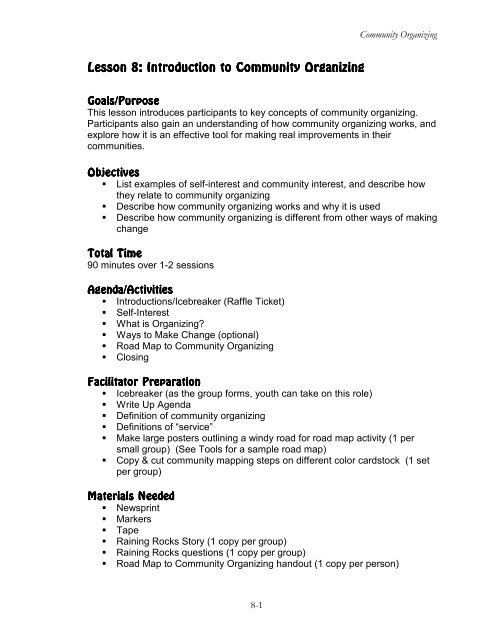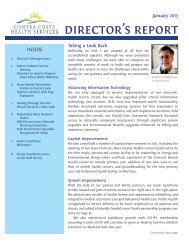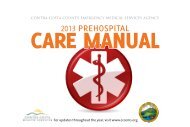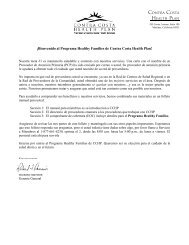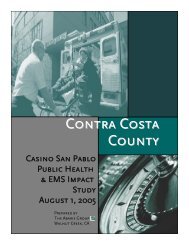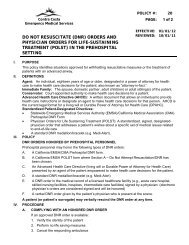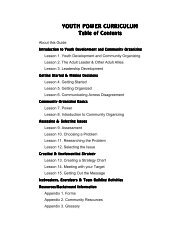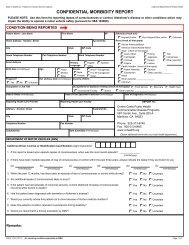Lesson 8: Introduction to Community Organizing Lesson 8 ...
Lesson 8: Introduction to Community Organizing Lesson 8 ...
Lesson 8: Introduction to Community Organizing Lesson 8 ...
You also want an ePaper? Increase the reach of your titles
YUMPU automatically turns print PDFs into web optimized ePapers that Google loves.
<strong>Lesson</strong> <strong>Lesson</strong> 8: 8: <strong>Introduction</strong> <strong>Introduction</strong> <strong>to</strong> <strong>to</strong> <strong>Community</strong> <strong>Community</strong> <strong>Organizing</strong> <strong>Organizing</strong><br />
<strong>Organizing</strong><br />
Goals/Purpose<br />
Goals/Purpose<br />
Goals/Purpose<br />
8-1<br />
<strong>Community</strong> <strong>Organizing</strong><br />
This lesson introduces participants <strong>to</strong> key concepts of community organizing.<br />
Participants also gain an understanding of how community organizing works, and<br />
explore how it is an effective <strong>to</strong>ol for making real improvements in their<br />
communities.<br />
Objectives<br />
Objectives<br />
List examples of self-interest and community interest, and describe how<br />
they relate <strong>to</strong> community organizing<br />
Describe how community organizing works and why it is used<br />
Describe how community organizing is different from other ways of making<br />
change<br />
Total Total Time<br />
Time<br />
90 minutes over 1-2 sessions<br />
Agenda/Activities<br />
Agenda/Activities<br />
<strong>Introduction</strong>s/Icebreaker (Raffle Ticket)<br />
Self-Interest<br />
What is <strong>Organizing</strong>?<br />
Ways <strong>to</strong> Make Change (optional)<br />
Road Map <strong>to</strong> <strong>Community</strong> <strong>Organizing</strong><br />
Closing<br />
Facilita<strong>to</strong>r Facilita<strong>to</strong>r Preparation<br />
Preparation<br />
Icebreaker (as the group forms, youth can take on this role)<br />
Write Up Agenda<br />
Definition of community organizing<br />
Definitions of “service”<br />
Make large posters outlining a windy road for road map activity (1 per<br />
small group) (See Tools for a sample road map)<br />
Copy & cut community mapping steps on different color cards<strong>to</strong>ck (1 set<br />
per group)<br />
Materials Materials Needed Needed<br />
Needed<br />
Newsprint<br />
Markers<br />
Tape<br />
Raining Rocks S<strong>to</strong>ry (1 copy per group)<br />
Raining Rocks questions (1 copy per group)<br />
Road Map <strong>to</strong> <strong>Community</strong> <strong>Organizing</strong> handout (1 copy per person)
Tools<br />
Tools<br />
Raining Rocks S<strong>to</strong>ry<br />
Raining Rocks questions<br />
Road Map <strong>to</strong> <strong>Community</strong> <strong>Organizing</strong><br />
8-2<br />
<strong>Community</strong> <strong>Organizing</strong>
The The The Basics<br />
Basics<br />
8-3<br />
<strong>Community</strong> <strong>Organizing</strong><br />
Direct action community organizing is one way <strong>to</strong> fix a problem. The thing that<br />
makes this method different from other ways of fixing problems is that it works <strong>to</strong><br />
challenge the power structure (pyramid of power) that allowed the problem <strong>to</strong><br />
happen in the first place.<br />
One well-known movement that successfully used direct action community<br />
organizing is the United Farm Workers, spearheaded by Cesar Chavez. By<br />
building coalitions with faith communities across the country and forging the<br />
support of unions, students, and consumers, Chavez built national support for a<br />
long-standing boycott of grapes. Non-violent tactics like picketing and a 340-mile<br />
march <strong>to</strong> Sacramen<strong>to</strong> also focused attention on the struggles of farm workers.<br />
These combined actions resulted in the first successful U. S. farm workers union<br />
and significant benefits for farm workers. Notably, the farm workers movement<br />
crossed both racial and class lines, and involved women, such as Dolores<br />
Huerta, in strong leadership roles.<br />
Direct action community organizing is when people who are affected by a<br />
problem decide on a solution, and with the strength of their numbers put pressure<br />
on politicians or whoever can make concrete improvements <strong>to</strong> the problem <strong>to</strong> do<br />
so. It’s about changing who has power; it’s about people coming <strong>to</strong>gether and<br />
building power <strong>to</strong> get what they want.<br />
Two key concepts in community organizing are self-interest and community<br />
interest. Many people see self-interest as a bad thing but it’s not. Self-interest<br />
is your concern for your priorities, your health and safety, and those of people<br />
that are connected <strong>to</strong> you (friends, family, neighbors). <strong>Community</strong> interest is a<br />
collective concern for priorities, health, and safety shared by a group of people.<br />
Self-interest and community interest motivate people <strong>to</strong> come <strong>to</strong>gether <strong>to</strong> get<br />
power and make change.<br />
In this section youth are asked <strong>to</strong> think about their self-interest. They are also<br />
asked <strong>to</strong> consider different ways of making change, and the power that a<br />
community can have when its members decide <strong>to</strong> work <strong>to</strong>gether <strong>to</strong> solve a<br />
problem.
8-4<br />
<strong>Community</strong> <strong>Organizing</strong><br />
1. Self Self Interest Interest<br />
10 minutes<br />
Materials: none<br />
After the raffle ticket icebreaker, have a short discussion about self-interest and<br />
community interest, and how they are related <strong>to</strong> community organizing. Use the<br />
following <strong>to</strong> guide your discussion:<br />
Ask youth <strong>to</strong> share their responses from the raffle ticket icebreaker “Why did<br />
you come here <strong>to</strong>day?” (eg., meet new people, fun, make my school or<br />
community better). Explain that these are examples of self-interest.<br />
Read aloud the definition of self-interest: a concern for your own priorities,<br />
your health and safety, and those of people close <strong>to</strong> you.<br />
Ask participants: Do you think self-interest is good?<br />
Explain that self-interest can be good because it gets people involved in<br />
things that are important <strong>to</strong> them.<br />
Next ask: What if your interest goes against what is good for most<br />
others? Is it still ok?<br />
Ask participants <strong>to</strong> complete the following sentence. If self-interest is<br />
what's good and important <strong>to</strong> one person then community interest is<br />
what 's important and good for ____________. (Answer: a number of<br />
people.)<br />
Explain that it is important <strong>to</strong> balance self-interest with community interest.<br />
Explain the connection <strong>to</strong> community organizing: People in power often use their<br />
power <strong>to</strong> satisfy their own self-interest. In community organizing, people come<br />
<strong>to</strong>gether <strong>to</strong> use their collective power <strong>to</strong> make sure that community interest is<br />
met.
2. What What is is <strong>Organizing</strong>? <strong>Organizing</strong>?<br />
1<br />
8-5<br />
<strong>Community</strong> <strong>Organizing</strong><br />
30 minutes<br />
Materials: Raining Rocks S<strong>to</strong>ry (1 copy per group), Raining Rocks questions (1<br />
copy per group)<br />
a. Explain that we are going <strong>to</strong> answer the question, “What is organizing?” The<br />
definition we use is "the process of bringing people <strong>to</strong>gether <strong>to</strong> use their<br />
collective power <strong>to</strong> win improvements in people's lives and challenge the<br />
power structure."<br />
Let youth know that you are going <strong>to</strong> read a short s<strong>to</strong>ry and then we’re going <strong>to</strong><br />
answer a few questions that will show what community organizing looks like.<br />
b. Read the Raining Rocks s<strong>to</strong>ry out loud (see Tools at the end of this section<br />
for handout).<br />
c. After the s<strong>to</strong>ry has been read out loud, divide the group in<strong>to</strong> three small<br />
groups corresponding <strong>to</strong> the three main groups in the s<strong>to</strong>ry. Group (1) will be the<br />
villagers who want <strong>to</strong> go up the mountain, Group (2) will be the villagers who<br />
want <strong>to</strong> continue the rescue, and Group (3) will be Filthy Richbanks and his<br />
friends.<br />
Each group answers the questions for their group (see Tools for handout). Each<br />
group should pick a recorder and someone <strong>to</strong> report back <strong>to</strong> the whole group.<br />
d. Facilitate report backs of each small group.<br />
e. Ask if anyone wants <strong>to</strong> comment on what they learned or observed.<br />
f. Then synthesize the activity:<br />
Point out that the exercise is about how <strong>to</strong> respond <strong>to</strong> a problem in the<br />
community. Some people want <strong>to</strong> minimize the damage of the fall and<br />
others want <strong>to</strong> s<strong>to</strong>p the rocks from falling.<br />
As we can see from Harrison Hotel it is only through the second approach<br />
that the boulders would actually s<strong>to</strong>p. This is what organizing looks like --<br />
looking at the root of the problem and getting people <strong>to</strong>gether <strong>to</strong> fight <strong>to</strong> fix<br />
it.<br />
1 Adapted from Political Education Manual, SOUL: A School <strong>to</strong> Build a Movement.
8-6<br />
<strong>Community</strong> <strong>Organizing</strong><br />
g. Ask, Does this mean that other ways <strong>to</strong> make change are not important?<br />
(Answer: No. There have <strong>to</strong> be many ways <strong>to</strong> fight the problems in our<br />
communities and we need <strong>to</strong> respect all people who are trying <strong>to</strong> make change<br />
and find solutions. However, we believe that organizing is the best way <strong>to</strong> make<br />
lasting change and address the root of the problem. <strong>Organizing</strong> can bring people<br />
<strong>to</strong>gether so that they can create and support the solution <strong>to</strong> a community<br />
problem.)<br />
3. Ways Ways <strong>to</strong> <strong>to</strong> <strong>to</strong> Make Make Change Change (optional) (optional) (optional)<br />
2<br />
Materials: chalk and chalkboard or poster of ways <strong>to</strong> make change<br />
20 minutes<br />
Draw the diagram below on the board <strong>to</strong> use as a guide for discussing different<br />
ways <strong>to</strong> make change.<br />
Accepts<br />
pyramid of power<br />
Services<br />
Self Help<br />
a. Explain that there are different ways <strong>to</strong> make change and the major ones are<br />
listed here on this graph. We’re going <strong>to</strong> go through an example <strong>to</strong> see different<br />
ways <strong>to</strong> fix a problem.<br />
The problem we’re going <strong>to</strong> look at is “there is nothing for young people <strong>to</strong> do.”<br />
Young people could go about getting things <strong>to</strong> do in many different ways.<br />
Education<br />
2 Adapted from <strong>Organizing</strong> for Social Change, Midwest Academy.<br />
Challenges<br />
pyramid of power<br />
Advocacy<br />
<strong>Community</strong><br />
<strong>Organizing</strong>
8-7<br />
<strong>Community</strong> <strong>Organizing</strong><br />
b. Go through each way <strong>to</strong> make change. Define each method for participants;<br />
write a one-<strong>to</strong>-two word explanation below each method as a guide for<br />
participants. Then ask the group <strong>to</strong> come up with an example of how <strong>to</strong> fix<br />
the problem using that method. Add the example next <strong>to</strong> that method on the<br />
graph. Repeat for each method of change.<br />
• Providing Service: Supply basic services <strong>to</strong> people who need them, often <strong>to</strong><br />
meet basic needs such as food, health care, etc.<br />
What it looks like: An organization like the boys and girls club could provide<br />
recreational activities for teens and charge membership <strong>to</strong> cover the costs.<br />
• Self Help: People affected by a problem do something <strong>to</strong> help each other.<br />
What it looks like: Teens plan and host weekly or monthly activities like dances,<br />
picnics, and sporting events.<br />
• Education: Letting people know about issues so that people affected by the<br />
issue can understand the problem.<br />
What it looks like: A group of youth survey other teens about the lack of activities<br />
for young people. They get an article published in the newspaper <strong>to</strong> let other<br />
teens and parents know about the problem. They also include a list of resources<br />
about the few teen activities going on in their community.<br />
• Advocacy: A group or organization that cares about a problem pleads the<br />
cause on behalf of the group affected by the problem.<br />
What it looks like: The PTA or residents association could give testimony <strong>to</strong> the<br />
mayor that the city should fund after-school activities for youth.<br />
• (Direct Action) <strong>Community</strong> <strong>Organizing</strong>: Bringing people <strong>to</strong>gether <strong>to</strong> use<br />
their collective power <strong>to</strong> win improvements in people’s lives and challenge the<br />
pyramid of power.<br />
What it looks like: Teens organize. They come <strong>to</strong>gether and agree on a solution<br />
that meets their needs. With their strength -- and the support of parents and<br />
other teens -- they pressure the politicians and officials responsible <strong>to</strong> provide<br />
more teen activities.
c. Discussion:<br />
8-8<br />
<strong>Community</strong> <strong>Organizing</strong><br />
Point out that each way of making change is connected differently <strong>to</strong> the<br />
pyramid of power challenging the pyramid of power. Services do not<br />
challenge the pyramid of power, community organizing is based on<br />
Reinforce that community organizing is the approach we’re going <strong>to</strong> use<br />
because it (1) builds power within the community (2) lets you (the community)<br />
come up with the best solution for yourself and (3) seeks long-term solutions<br />
<strong>to</strong> the problem.<br />
4. Road Map Map <strong>to</strong> <strong>Community</strong> <strong>Organizing</strong> 30 minutes<br />
Materials: blank road maps on newsprint (1 per group), a set of ‘pit s<strong>to</strong>ps’ (1 per<br />
group)<br />
a. Remind the group that when we talked about power we went over some<br />
vic<strong>to</strong>ries won through community organizing (eg, TIGHT, ECYC, and ETA). Now,<br />
we are going <strong>to</strong> get down <strong>to</strong> the specifics about how community organizing works<br />
and the different steps <strong>to</strong> successful organizing.<br />
b. Explain that this activity is going <strong>to</strong> be like a road map. Each group is going<br />
<strong>to</strong> get a road map and a set of pit s<strong>to</strong>ps. It is your job <strong>to</strong> decide <strong>to</strong>gether where<br />
the s<strong>to</strong>ps belong on the road map. Each map has ‘road signs’ on it – these are<br />
guides <strong>to</strong> help you figure out where the different pit s<strong>to</strong>ps belong.
c. Use the following road map as a guide:<br />
8-9<br />
<strong>Community</strong> <strong>Organizing</strong>
8-10<br />
<strong>Community</strong> <strong>Organizing</strong><br />
d. Divide the large group in<strong>to</strong> smaller groups of 3-5 people. Ask each group <strong>to</strong><br />
identify a reporter and a timekeeper for the group. Give the groups 10 minutes <strong>to</strong><br />
complete their road map.<br />
e. Once completed, post the road maps where everyone can see them. Give<br />
each group 3 minutes <strong>to</strong> report back <strong>to</strong> the large group about their roadmap.<br />
Compare the different ways groups mapped their route. Groups might want <strong>to</strong><br />
make some changes after discussing <strong>to</strong>gether.<br />
Acknowledge that there is a general order <strong>to</strong> how community organizing works<br />
but that often making change takes a long time. So, sometimes changes happen<br />
while you are working <strong>to</strong> fix the problem and you might make changes along the<br />
way or repeat some steps.<br />
f. Emphasize that the action planning is critical <strong>to</strong> success! It might take some<br />
time <strong>to</strong> research the issue and build relationships with the people on your side<br />
(allies), but it is worth it – because this will help you WIN.
Tools Tools – <strong>Lesson</strong> 8<br />
<strong>Community</strong><br />
<strong>Community</strong><br />
<strong>Organizing</strong><br />
<strong>Organizing</strong>
RAINING RAINING ROCKS ROCKS STORY: STORY: A A PARABLE PARABLE<br />
3<br />
Once upon a time there was a little <strong>to</strong>wn in the mountains called Swiss<strong>to</strong>wn.<br />
One winter, a villager taking a walk in the hills finds a man lying in the snow – he<br />
has been hit by a falling rock. The villager, being a very caring person, uses her<br />
jacket <strong>to</strong> bandage the injured man and carries him back down <strong>to</strong> the village.<br />
The next day two more people are hit by falling rocks, and they are rescued by<br />
other villagers. The next day, four people are hurt, then eight, then twenty. Life<br />
becomes dangerous for all villagers, because rocks keep falling down. A couple<br />
of villagers sneak up the mountain and discover that the rocks are being thrown<br />
by a millionaire, Harrison Hotel, and his friends who hope <strong>to</strong> build a luxurious<br />
hotel and golf course in Swiss<strong>to</strong>wn. They are throwing the rocks hoping <strong>to</strong> get rid<br />
of the villagers so they can take over the land.<br />
The Disaster Relief Agency shows up in <strong>to</strong>wn. They set up a huge rescue<br />
operation. They set up a clinic <strong>to</strong> heal the injured, send dogs <strong>to</strong> find injured<br />
people who are lost outside, a shelter for those whose homes are destroyed, and<br />
social workers <strong>to</strong> help people deal with the traumatic effects of the falling rocks.<br />
Finally, The Disaster Relief Agency makes a giant net <strong>to</strong> place over Swiss<strong>to</strong>wn <strong>to</strong><br />
s<strong>to</strong>p the rocks from falling.<br />
One day, the net breaks and rocks fall on the village, injuring hundreds and<br />
destroying homes, schools, and s<strong>to</strong>res. The Disaster Relief Agency is working<br />
furiously <strong>to</strong> heal and provide shelter. From then on, rescue work becomes an<br />
important part of the villagers’ lives. Everyone becomes involved in helping<br />
those hurt by the falling rocks.<br />
Three months later, at a <strong>to</strong>wn meeting, a group of villagers get <strong>to</strong>gether <strong>to</strong> make<br />
a proposal. They are sick and tired of the falling rocks, of their people being hurt,<br />
and they want <strong>to</strong> change the situation. They propose that the villagers unite and<br />
go up the mountain <strong>to</strong> demand that Harrison Hotel s<strong>to</strong>p dropping the rocks.<br />
Some disagree, saying that Swiss<strong>to</strong>wn’s rescue and relief efforts can’t afford it. If<br />
anyone leaves, there won’t be enough people power <strong>to</strong> rescue and tend <strong>to</strong> the<br />
injured.<br />
The <strong>to</strong>wn is split in two groups – those who want <strong>to</strong> stay and keep up the rescue<br />
effort going, and those who want <strong>to</strong> march up the mountain and confront Harrison<br />
Hotel.<br />
3 Adapted from Political Education Manual, SOUL: A School <strong>to</strong> Build a Movement
RAINING RAINING ROCKS ROCKS QUESTIONS QUESTIONS<br />
4<br />
GROUP GROUP ONE: ONE: Villagers Villagers who who want want <strong>to</strong> <strong>to</strong> go go go up up the the mountain<br />
mountain<br />
Discuss the questions and pick one spokesperson who can explain your<br />
answers <strong>to</strong> the larger group.<br />
In the s<strong>to</strong>ry, what is your strategy in dealing with the falling rocks problem?<br />
Do you think your strategy is successful? Why or why not?<br />
How would the scenario end if your strategy is used?<br />
GROUP GROUP GROUP TWO: TWO: TWO: Villagers Villagers Villagers who who who want want want <strong>to</strong> <strong>to</strong> <strong>to</strong> keep keep keep up up up the the the rescue rescue effort effort<br />
effort<br />
Discuss the questions and pick one spokesperson who can explain your<br />
answers <strong>to</strong> the larger group.<br />
In the s<strong>to</strong>ry, what is your strategy in dealing with the falling rocks problem?<br />
Do you think your strategy is successful? Why or why not?<br />
How would the scenario end if your strategy is used?<br />
GROUP GROUP THREE: THREE: The The Millionaire Millionaire and and his his friends<br />
friends<br />
Discuss the questions and pick one spokesperson who can explain your<br />
answers <strong>to</strong> the larger group.<br />
Which of the two groups do you think you could work with more closely <strong>to</strong><br />
achieve your goal?<br />
Which of the two groups is more threatening <strong>to</strong> you and your goal <strong>to</strong> build<br />
a golf course and luxurious hotel?<br />
What is your strategy in dealing with the two groups in order <strong>to</strong> achieve<br />
your goal of building the golf course and luxurious hotel?<br />
4 Adapted from Political Education Workshop Manual, SOUL: A School <strong>to</strong> Build A Movement


